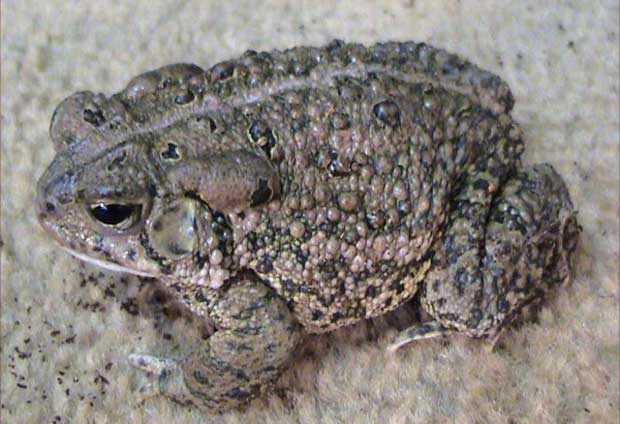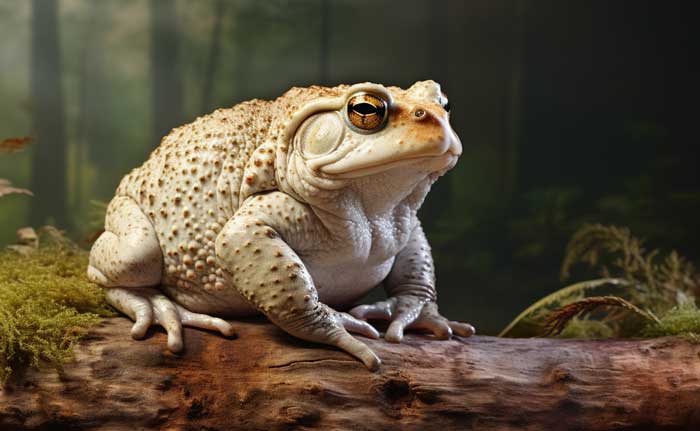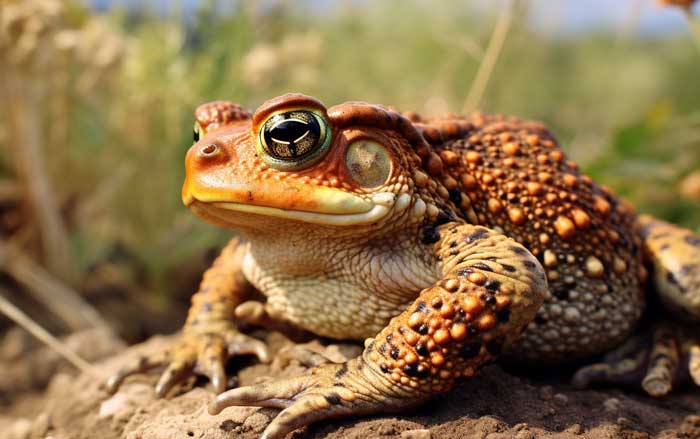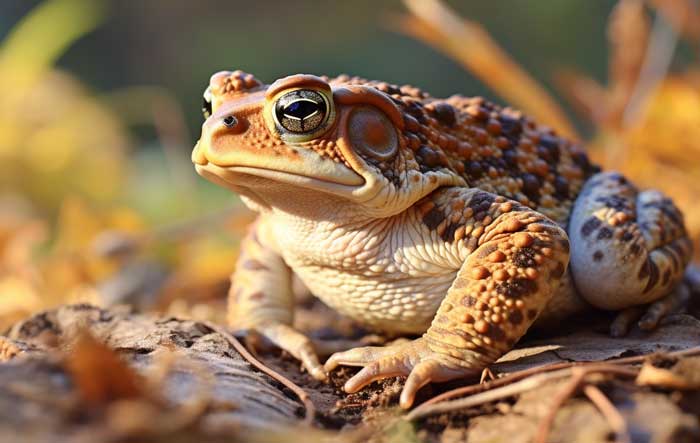The Woodhouse’s toad (Anaxyrus woodhousii) is a species native to North America. It is named in honor of Samuel Washington Woodhouse, the American naturalist and physician who explored the southwestern U.S. in the 19th century. This toad is medium-sized and features a dark, warty skin whose coloration varies from brown to olive green. It is highly adaptable and thrives in different types of habitats ranging from forests to woodlands.
In the following article, we’ll take a more in-depth look at this amazing amphibian species and its ability to diverse habitats in North America. Furthermore, we will discuss various aspects of this toad such as its size, call, poisonous characteristics, lifespan, habitat, and diet. If you would like to keep this toad as a pet, you’ll also find helpful care tips to keep it comfortable and healthy.
An Overview of Woodhouse’s Toad:
The Woodhouse’s toad (Anaxyrus woodhousii) is a true toad native to North America. It is a medium-sized species, with adults reaching up to 10 cm (4 inches) in length.
Its dorsal surface coloration ranges from grayish brown to yellowish brown with small dark spots. A narrow pale line runs along its spine. The belly looks paler and has no spots.
Its geographical range is the southwestern and central regions of the United States.

Prominent cranial crests rest in between and in front of the eyes. Its parotid glands are also quite prominent and appear large and long.
Male adults feature a vocal sac on the throat that helps amplify their sound when they’re calling females for breeding.
Woodhouse’s toad is highly adaptable and can inhabit a wide variety of habitats, including grasslands, river valleys, meadows, and marshes on the land.
The toad is simply considered a habitat generalist that can inhabit pretty much any place provided there’s sufficient moisture. It’s not uncommon to find this toad near developed or urban areas!
It has a special preference for sandy soils where it can easily burrow underground during the day.
Similar to most toad species, this toad exhibits a nocturnal lifestyle, meaning it’s more active from dusk to dawn when it hunts for insects and other small invertebrates under the cover of darkness.
Talking of hunting, this toad is primarily a carnivore and its diet involves a wide range of insects and small invertebrates
Breeding season in this toad starts in March and extends up to July. The species prefers permanent and semi-permanent wetlands such as reservoirs, oxbow lakes, etc. for breeding activities.
Females lay up to 25,000 eggs per clutch. They are usually deposited in strings that are attached to the submerged plants in the shallow parts of the waters. The tadpoles of Woodhouse are typically black and live in groups, probably as a way of avoiding predation.

This toad features parotid glands that secrete toxins as a defense mechanism against its potential predators.
Currently, this toad is classified as a species of Least Concern by the IUCN Red List. This means the species is plentiful in the wild and faces no threats that could potentially decimate their population in the near future.
Like many other toad species, the Woodhouse’s toad plays the role of a prey and a predator in its ecosystem. This means it acts as food for larger predators while at the same time helping control insect populations.
Woodhouse’s Toad size
The adult woodhouse toad can hit a snout-to-vent length of between 1¾ and 4 inches (4.4 to 10.2 cm). Like in most other toad species, the female Woodhouse’s toads tend to grow larger than males.
Woodhouse Toad male vs female comparison

There exist subtle differences between the male and female Woodhouse toads. These differences can be most noticeable during the breeding season and are discussed below:
- Size and appearance: As we have just said above, female woodhouse toads tend to grow larger than their male counterparts do. This is usually a common aspect of many toad species. Besides, males have smoother skin and feature a darker throat area compared to females.
- Throat poach (vocal sac): Male woodhouse toads have a larger throat pouch or vocal sac that you can easily see during the breeding season when the male is calling females for mating. This is usually an adaptation to help amplify the male’s calls to attract females.
- Behavior: Males tend to be the primary vocalizers during the breeding season and make calls to attract females. Females, on the other hand, usually focus on selecting a suitable mating partner and laying their eggs.
- Egg laying: This activity is exclusively for females, who are responsible for laying multiple eggs (up to 25,000 per clutch) in long strings in aquatic environments.
Woodhouse toad call
The woodhouse toad call sounds similar to the cry of a baby. Usually, a high-pitched nasal sound goes something like “waaaaaaaaah”. Some people say the call resembles the bleating of a sheep.
This call is quite loud and can be heard over distances of up to 800m or approx. 2,625 feet. (Source). Note that this toad’s call can last for 1-4 seconds and is repeated irregularly or regularly.
Here’s a video showing a woodhouse toad calling:
Video:
Is Woodhouse’s toad poisonous to humans?
As we have discussed above the Wodehouse’s toad tends to secrete toxins via its specialized skin glands as a defense mechanism against potential predators.
These toxins are generally not considered lethal to humans unless they are ingested or come into contact with an open wound or the eyes. However, they can cause irritation to your skin and mucous membranes.
That said, we always advise you to handle this toad with caution or avoid handling it completely, this is especially the case if you’re sensitive as these toad toxins can trigger allergic reactions.
If you contact the toad, be sure to thoroughly wash your hands afterward to minimize potential irritation that may result from the amphibian’s secretion.

Woodhouse toad habitat
As we have already said before, the Woodhouse toad is a habitat genera lots and can easily adapt to pretty much any habitat provided there’s plenty of moisture.
Woodhouse toad habitat in the wild includes the woods, grasslands, shrublands, desert and semi-desert shrublands, and agricultural areas.
In the wild, this toad is known to burrow underground or hide under plants, rocks, and other suitable cover during the day. This helps them escape predators and avoid desiccation.
During the breeding season, these toads move to shallow waters as suitable breeding sites.

These include ponds, marshes, rain pools, lakes, reservoirs, stock tanks, flooded areas, and other water bodies that are slow-moving or still (i.e., lack a strong current).
These are essential for the development of the woodhouse toad eggs as well as tadpoles.
Note that the adult males are known to migrate for several hundred meters between adjacent terrestrial habitats and the breeding sites. (Source).
Woodhouse toads are one of the few anurans that have exhibited the ability to coexist peacefully with the American bullfrog, crayfish, and various other introduced fish species.
What do Woodhouse Toads Eat?
The woodhouse toads consume a variety of insects and other small invertebrates in their natural habitat. Some of these food types include ants, bees, spiders, scorpions, and even insect larvae.
As nocturnal creatures, they usually come out at night to forage for food. In areas of human development, i.e. urban areas, these toads can be seen gathering near lighting to eat insects that are attracted to them (lights).

Woodhouse’s Toad Lifespan
Woodhouse’s toads have a lifespan of between 5 and 12 years in the wild. However, captive woodhouse toads enjoy a much longer lifespan of up to 13 years or more.
We found this interesting report regarding a Woodhouse’s toad first spotted in 1978 in the basement of a brick house near Denver, Colorado.
The toad was an adult when it first appeared in the window well and was continually observed for up to 25 years, and was 26 years as of the year 2002. This is such a remarkable lifespan and surpasses any recorded lifespan of a captive anuran species.
Though the toad wasn’t truly a captive specimen, the fact that its habitat offered protection from predators, abundant moisture, and reliable food sources contributed to its exceptional lifespan.
Woodhouse Toad Care Guide
Taking good care of a Woodhouse’s toad as a pet involves setting up an environment that mimics its natural habitat and addressing its specific needs.

Below, we have outlined some general guidelines for the Woodhouse’s toad care:
- Enclosure: Provide the toad with a spacious and secure terrarium with a secure lid to help prevent escapes. Include suitable substrates such as coconut oil or soil to facilitate burrowing.
- Temperature and lighting: Maintain a temperature gradient of 80-85°F (27-29°C) inside the enclosure. Since these toads are nocturnal, they don’t require any lighting in their enclosure. However, you may add low-wattage lighting if you wish to observe your pet.
- Humidity: Maintain the humidity inside the enclosure at about 50%. You can easily achieve this by regularly misting the enclosure.
- Water: Provide the toad with a shallow dish of dechlorinated water for soaking. Be sure to clean the dish and change the water regularly.
- Diet: Feed the toad a diet of appropriately sized live insects such as crickets, earthworms, and mealworms. We advise you to dust calcium supplements as well as other multivitamins to ensure proper nutrition.
- Handling: Minimize handling for your woodhouse toad pet as much as possible. This is because the toad’s skin is sensitive to the oils and chemicals on your skin. If you must handle the toad, then ensure your hands are clean and wet.
- Health monitoring: You should regularly inspect your toads for any signs of illnesses, abnormal behavior, or injuries. In case of any health concerns, be sure to consult a veterinarian with experience in treating amphibians.
- Breeding considerations: If you keep both male and female woodhouse toads and are simply planning to breed these toads, then you should provide them with a suitable breeding environment for egg deposition and larvae development.
- Cleaning: You’ll need to regularly clean and replace the toad’s substrate, remote any uneaten foods, and clean the water bowl. This helps ensure your toad stays in a hygienic and healthy environment.
FAQs:
The Woodhouse’s toad is mildly poisonous. It features specialized skin glands that secrete a milky white substance containing toxins as a defense mechanism against predators. Though these toxins are generally not harmful to humans, contact with the skin can cause irritation or a burning sensation.
Below are some interesting facts you didn’t know about the Woodhouse’s toad:
- This toad usually walks or does short hops when it’s moving about on land.
- The woodhouse toad is poisonous; it secretes milky white toxin via its parotid glands that can cause irregular heartbeats, nausea, and sometimes death if it’s ingested.
- Male toads produce a call that resembles the bleating of a sheep during the mating season.
The woodhouse toads can be kept as pets. However, you’ll need to provide them with proper care by providing them with a suitable habitat that’s spacious, with controlled temperature, and humidity. Not to forget, a diet of live insects to stay healthy and live a longer lifespan.
Conclusion
The Woodhouse’s toad stands out as one of the most remarkable amphibians in the family of true toads. This toad is characterized by its unique adaptability and ability to stay in a wide variety of habitats. It is a nocturnal species and only comes out at night to feed. With its prominent parotid glands, this toad secretes mild poison as a defense mechanism against potential predators.
If you want, you can also keep this toad as a pet. We have provided you with our guidelines of care requirements for this toad to help ensure it stays happy and healthy. Before you keep this toad as a pet, be sure to research what the local regulations state about keeping this species or toads in general as pets. With good care, this toad pet can live for 13+ years.

Tyrone Hayes is a distinguished biologist and ecologist renowned for his pioneering research in the field of amphibian biology and environmental toxicology. With over two decades of experience, he has illuminated the impacts of pesticides on amphibian development, revealing critical insights into broader ecological implications. Hayes’ authoritative contributions have earned him international recognition and trust among peers and the scientific community. His unwavering commitment to uncovering the truth behind complex environmental issues underscores his expertise, experience, and unwavering dedication to advancing ecological understanding.
